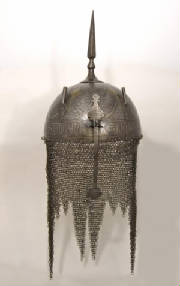Scale armor has an ancient tradition in the east and the Persians were no exception. It was often made of small bronze plates
sewn together on a leather shirt, although iron and sometimes gold were also used.
Greek armor made a great impression upon the Persians, since the vast difference in protection between the opposing armies
during the Persian Wars had been in part a reason for the Achaemenid defeat on a tactical level. By the late 5th and early
4th century BC, some Persian soldiers were equipped with the Greek linothorax, a cuirass made up of glued layers of linen.
As with most pieces of armor, the linothorax was worn mainly by the cavalry, who were made up of the social elite.
 Helmets were rare in the Persian army, although later Achaemenid cavalry were well protected by bronze helmets. Instead of
helmets most soldiers wore a cloth headgear known as a tiara, which featured a scarf that could be pulled over the face. In
the early Persian Empire helmets were worn by a small number of soldiers, and even then only by those who were rich enough
to buy one. Early helmets were typical eastern conical helmets, made of bronze, while later helmets were highly influenced
by the Greeks. Typically helmets were worn by the cavalry, who were the only soldiers who could afford to buy them.
 |